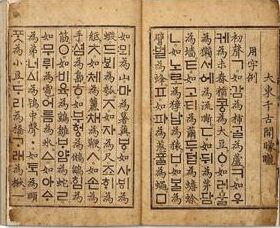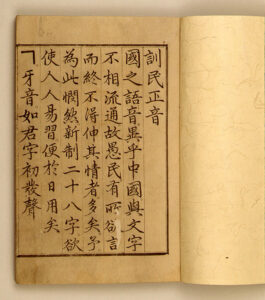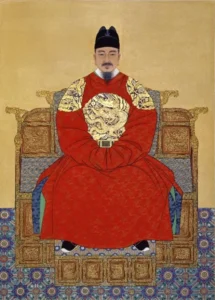Hunminjeongeum (훈민정음), meaning “The Correct Sounds for the Instruction of the People,” is more than just a writing system—it is a cultural and intellectual revolution. Created by King Sejong the Great of Joseon in 1443 and promulgated in 1446, Hunminjeongeum laid the foundation for Hangeul, the Korean alphabet, making literacy accessible to all Koreans regardless of class or status.
Recognized as a UNESCO Memory of the World in 1997 and designated as National Treasure No. 70 in South Korea, Hunminjeongeum is a symbol of equity, national identity, and linguistic innovation.

Historical Background
In the early 15th century, Korea’s written language relied heavily on Classical Chinese (Hanja). While used by the elite, Chinese characters were difficult for the general public to learn, as they were not phonetic and did not align well with the Korean spoken language.
King Sejong, known for his deep compassion for the people, recognized the severe literacy gap between the ruling elite and commoners. He initiated the creation of a unique, simple, and scientifically structured script that would allow everyone, including women and peasants, to express themselves in writing.
In the preface to Hunminjeongeum, King Sejong wrote:
“Because the speech of this country is different from that of China, the Chinese characters do not correspond to the sounds. Therefore, even if the ignorant want to express themselves, many are unable to do so. I have been troubled by this and have created 28 new letters so that people may easily learn and use them in their daily lives.”

Structure and Principles of Hunminjeongeum
Composition
Originally, Hunminjeongeum consisted of 28 characters:
- 17 consonants
- 11 vowels
Today, 24 letters (14 consonants and 10 vowels) remain in use.
Phonetic Design
The genius of Hunminjeongeum lies in its scientific and systematic design:
- Consonants were designed based on the shape of the speech organs during articulation.
- For example, the shape of ㄱ (g/k) mimics the back of the tongue blocking the throat.
- Vowels reflect cosmic philosophy, incorporating:
- A dot (•) for the sky
- A horizontal line (ㅡ) for the earth
- A vertical line (ㅣ) for humans
This triad reflects traditional East Asian metaphysics—heaven (天), earth (地), and human (人).
The letters were designed to be easily learnable yet able to represent complex phonological structures.
The Hunminjeongeum Haerye
In 1940, a rare manuscript titled Hunminjeongeum Haerye (훈민정음 해례본) was discovered in Andong, Korea. This text is an annotated edition of the original proclamation, detailing:
- The rationale behind the script’s creation
- The formation of each letter
- Usage rules and phonological theory
This discovery greatly expanded our understanding of the script’s origin, philosophy, and intended use.
Today, the Haerye manuscript is housed at the Gansong Art Museum and is considered the only authentic copy of the original document.
Cultural and Historical Significance
Symbol of Equality
Hunminjeongeum stands as a monument to egalitarianism. It broke the monopoly of literacy held by the aristocracy and allowed all Koreans, regardless of social class, to read and write.
Foundation of Korean Identity
Hangul has become a cornerstone of Korean national identity. Unlike countries colonized linguistically by foreign scripts, Korea boasts a writing system created by its own people for its own language.
This unique status makes Hangul one of the few alphabets in the world with a known creator and exact creation date.

UNESCO Recognition and Global Legacy
In 1997, Hunminjeongeum was inscribed in the UNESCO Memory of the World Register due to its immense cultural and historical value.
Its legacy extends beyond Korea:
- Linguists admire its phonetic clarity and logical structure.
- Educators study it as a model for literacy reform.
Technologists incorporate its features into AI and natural language processing due to its regularity and efficiency.
Modern Use and Celebration
Today, Hangeul, the modern adaptation of Hunminjeongeum, is the official script of South and North Korea.
Hangeul Day
Each year on October 9 (South Korea) and January 15 (North Korea), Koreans celebrate Hangeul Day in honor of King Sejong’s contribution to literacy, culture, and identity.
Education and Outreach
South Korea emphasizes Hangul education from early childhood and promotes literacy programs in developing countries based on the Hunminjeongeum model.
Hunminjeongeum
Hunminjeongeum is more than a writing system—it is a cultural treasure, a scientific innovation, and a symbol of empowerment.
Created by King Sejong the Great with compassion and foresight, it reflects the belief that language should be accessible to all, not just the elite. As one of the world’s most scientifically structured alphabets, it continues to inspire scholars, linguists, and educators across the globe.
As Korea continues to grow in global influence, from K-pop to technology, the legacy of Hunminjeongeum remains at the heart of its cultural pride.
References
Other Relevant Readings
- King Sejong
- Joseon
- Jiphyeonjeon
- Hangeul
- Seonbi, Scholars of Joseon
- Yangban
Introduction & Hangeul >>
